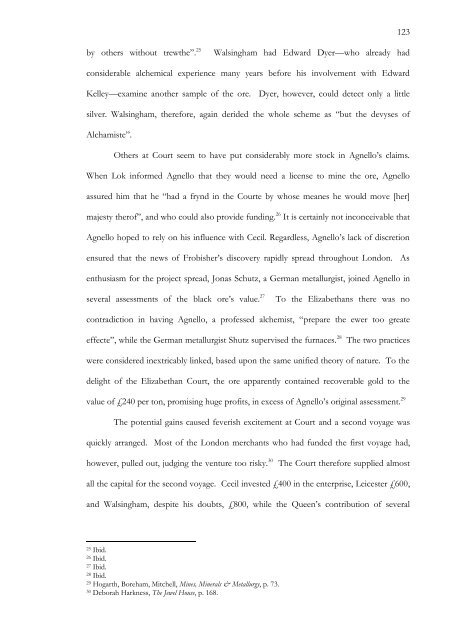The Alchemical Patronage of Sir William Cecil, Lord Burghley
The Alchemical Patronage of Sir William Cecil, Lord Burghley
The Alchemical Patronage of Sir William Cecil, Lord Burghley
You also want an ePaper? Increase the reach of your titles
YUMPU automatically turns print PDFs into web optimized ePapers that Google loves.
y others without trewthe‖. 25 Walsingham had Edward Dyer—who already had<br />
considerable alchemical experience many years before his involvement with Edward<br />
Kelley—examine another sample <strong>of</strong> the ore. Dyer, however, could detect only a little<br />
silver. Walsingham, therefore, again derided the whole scheme as ―but the devyses <strong>of</strong><br />
Alchamiste‖.<br />
Others at Court seem to have put considerably more stock in Agnello‘s claims.<br />
When Lok informed Agnello that they would need a license to mine the ore, Agnello<br />
assured him that he ―had a frynd in the Courte by whose meanes he would move [her]<br />
majesty ther<strong>of</strong>‖, and who could also provide funding. 26 It is certainly not inconceivable that<br />
Agnello hoped to rely on his influence with <strong>Cecil</strong>. Regardless, Agnello‘s lack <strong>of</strong> discretion<br />
ensured that the news <strong>of</strong> Frobisher‘s discovery rapidly spread throughout London. As<br />
enthusiasm for the project spread, Jonas Schutz, a German metallurgist, joined Agnello in<br />
several assessments <strong>of</strong> the black ore‘s value. 27 To the Elizabethans there was no<br />
contradiction in having Agnello, a pr<strong>of</strong>essed alchemist, ―prepare the ewer too greate<br />
effecte‖, while the German metallurgist Shutz supervised the furnaces. 28 <strong>The</strong> two practices<br />
were considered inextricably linked, based upon the same unified theory <strong>of</strong> nature. To the<br />
delight <strong>of</strong> the Elizabethan Court, the ore apparently contained recoverable gold to the<br />
value <strong>of</strong> £240 per ton, promising huge pr<strong>of</strong>its, in excess <strong>of</strong> Agnello‘s original assessment. 29<br />
<strong>The</strong> potential gains caused feverish excitement at Court and a second voyage was<br />
quickly arranged. Most <strong>of</strong> the London merchants who had funded the first voyage had,<br />
however, pulled out, judging the venture too risky. 30 <strong>The</strong> Court therefore supplied almost<br />
all the capital for the second voyage. <strong>Cecil</strong> invested £400 in the enterprise, Leicester £600,<br />
and Walsingham, despite his doubts, £800, while the Queen‘s contribution <strong>of</strong> several<br />
25 Ibid.<br />
26 Ibid.<br />
27 Ibid.<br />
28 Ibid.<br />
29 Hogarth, Boreham, Mitchell, Mines, Minerals & Metallurgy, p. 73.<br />
30 Deborah Harkness, <strong>The</strong> Jewel House, p. 168.<br />
123















